The dangers of fishing line and hooks for birds and other wildlife are real and damaging.
I see and photograph incredible birds and wildlife often, and it brings me much joy. But there’s a flip side to my photography that is saddening, maddening, and deeply disheartening. I don’t always see beauty. Sometimes, I see pain, suffering, and death.
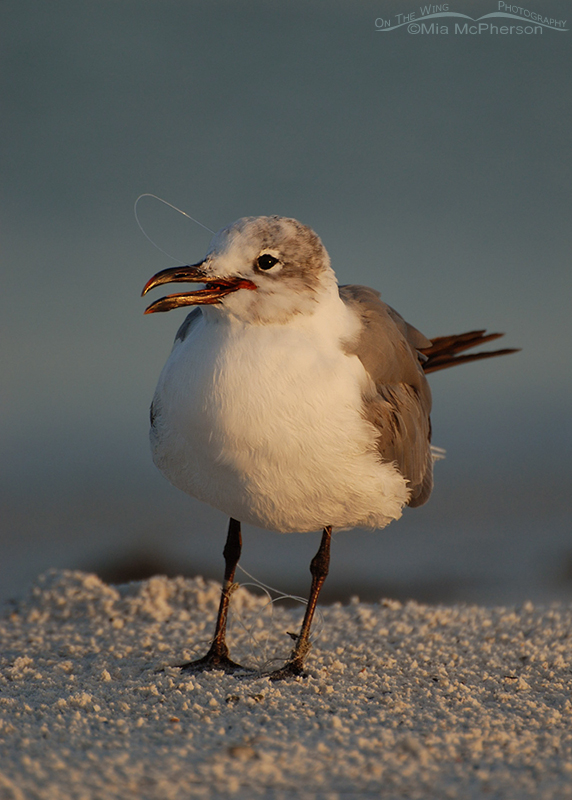 Laughing Gull with fish hook in bill and legs too tangled to walk
Laughing Gull with fish hook in bill and legs too tangled to walk
I recall vividly the morning I spotted this Laughing Gull. It wasn’t acting like the other gulls nearby, so I focused on the bird and felt my stomach twist into a knot as it became clear that the gull had a fish hook embedded in its throat and bill. It couldn’t close its bill. Then I noticed that its feet were entangled in monofilament fishing line so badly that it could barely walk. All it could do was shuffle its feet.
I wanted to get help for the Laughing Gull but at the time I didn’t have a smart phone, I had no access to the internet and I didn’t have the number to the park’s headquarters. Plus I couldn’t capture the bird to take to a rescue group because it could still fly. When it did fly off the knot in my gut worsened because I knew that without help the gull would soon die. That is such a helpless feeling.
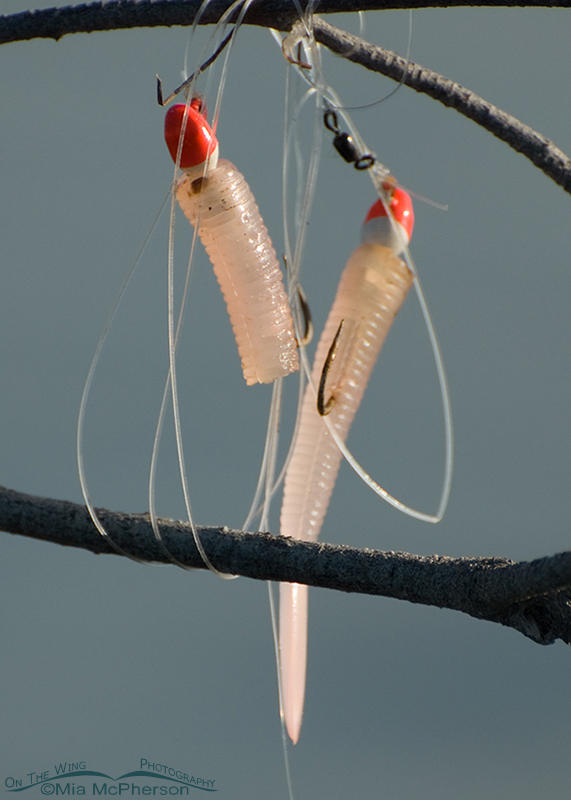 Fishing Lures left on a snag in a tidal lagoon
Fishing Lures left on a snag in a tidal lagoon
Monofilament fishing line, lures, hooks, metal leads and weights present huge dangers to birds and wildlife when they are not properly disposed of. Monofilament lines can tangle around the bills, feet, wings, legs and necks of birds which can result in death, amputations of feet, legs and wings and when the line is around the neck the possibility of a slow, painful strangulation.
After photographing these lures I removed them from the snag and disposed of them properly. The snag wasn’t in deep water, it only came to my knees and I don’t understand why the fishermen didn’t wade out and remove it. I can’t understand.
 White Ibis with foot tangled in fishing line
White Ibis with foot tangled in fishing line
I can not count the times I have encountered a bird with missing feet or partial amputations of their legs. I have just seen that many.
The fishing line is tangled around the foot so tight of this White Ibis that the foot is extremely swollen and it appeared obviously painful to the bird because it did not place that foot on the ground while I observed it, instead it hopped on the other leg to move on the ground. The Ibis flew off before I could call the Suncoast Seabird Sanctuary in St. Petersburg to ask for help. Once again I wondered about the fate of this beautiful bird.
After my experience with the Laughing Gull tangled in fishing line I added the phone numbers for the Suncoast Seabird Sanctuary and the park headquarters in my contacts list in my cell phone.
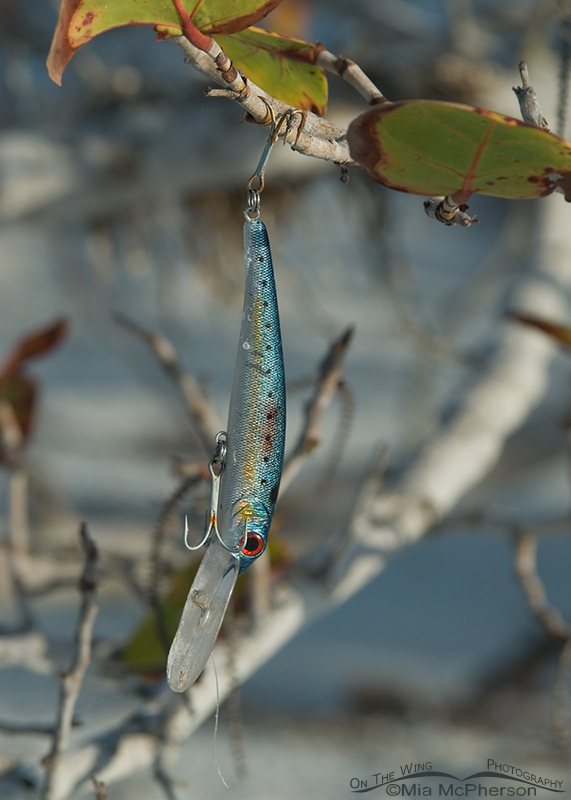 Fishing lure
Fishing lure
Quite often fishing lures resemble fish, shrimp or other food items for the intended targets of the fishermen. The problem is that these lures often look enticing to birds, mammals and sea creatures. I found this lure while walking along a sandy beach and not only could it have become an item to kill birds or wildlife it could have gotten stuck in the soles of a child’s foot who then may not have only been in pain but might have been subjected to Tetanus injections or have developed an infection.
I picked the lure up, placed it in this tree to photograph it, and then carried it to a trash receptacle to dispose of it. A pretty simple way of protecting wildlife and people from the dangers of this lure. I wish it were done more often.
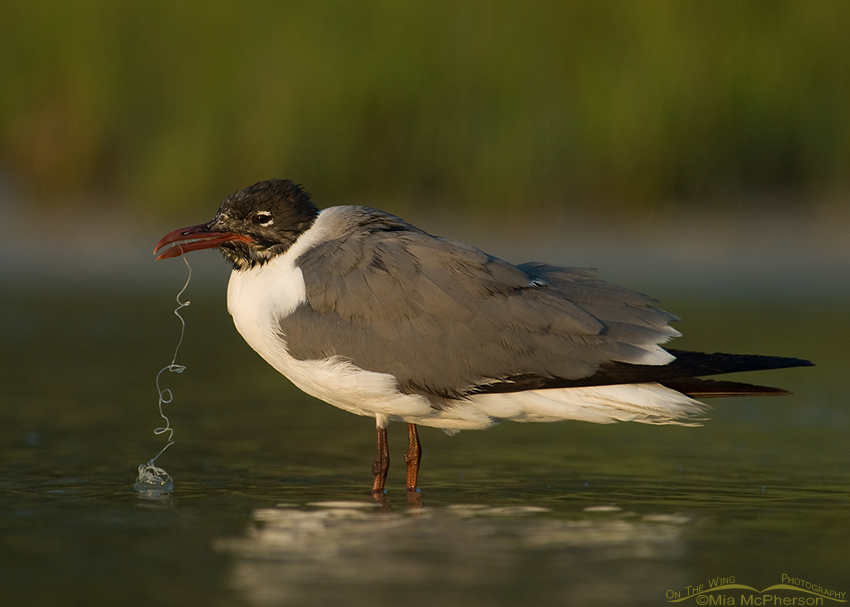 Laughing Gull with fishing line & lure in bill
Laughing Gull with fishing line & lure in bill
This Laughing Gull had obviously swallowed a hook or a lure and had a long strand of the fishing line hanging from its bill the evening that I photographed it. I was heart broken that before I could call for help a person walked close enough to make the gull fly away.
If I could have reached the park rangers at Fort De Soto County Park or the rescue group they may have been able to throw a net over the bird to capture it, remove the hook and release it.
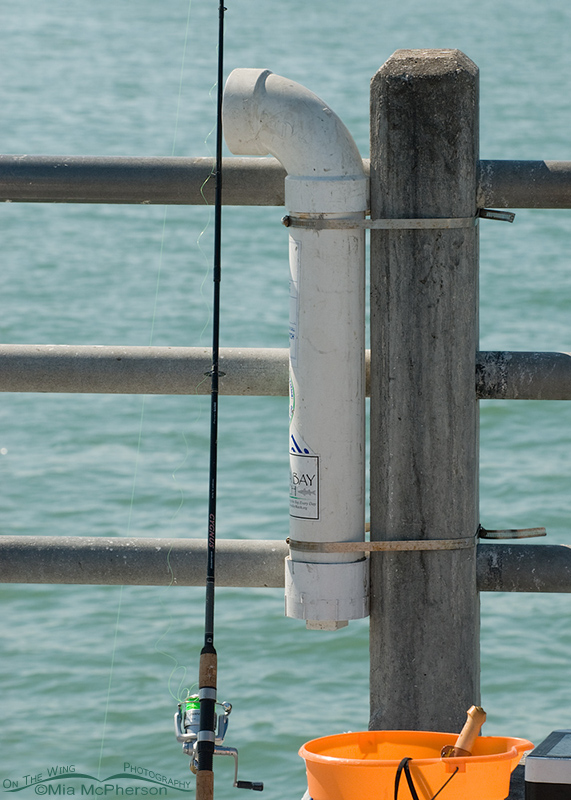 Used fishing line container
Used fishing line container
Many parks and recreation areas have now installed used fishing line containers within easy walking distance to fishing areas where fishing line, weights, leads, hooks and lures can be properly and safely disposed of. I find it sad that even in locations with these containers that I still find fishing line and hooks on the ground presenting dangers to birds, wildlife and people.
Is there an excuse for not walking a few feet to get rid of these items in a safe manner?
I don’t think so.
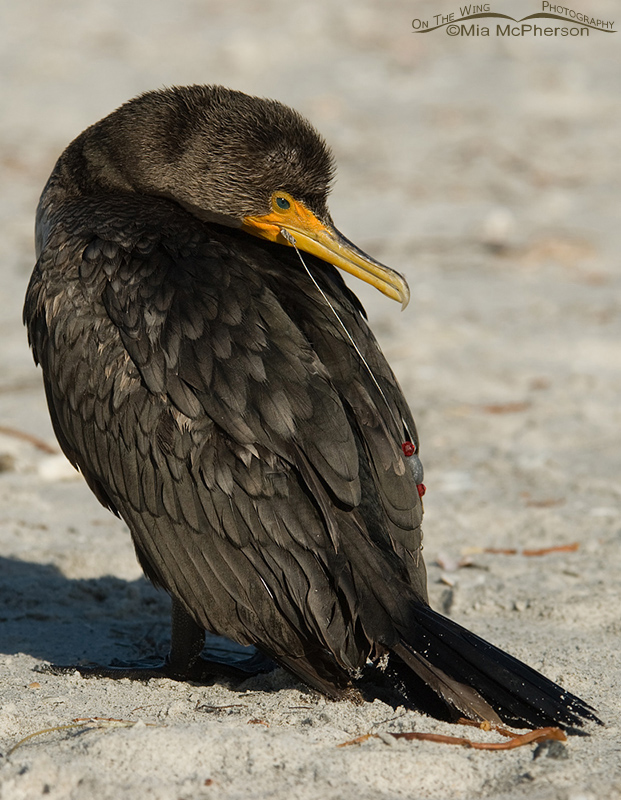 Double-crested Cormorant in danger
Double-crested Cormorant in danger
I have been able to aid in the rescue of several birds including the Double-crested Cormorant shown above. I was photographing birds near the Gulf Pier at Fort De Soto when I noticed this bird sitting on the beach.
I could see the hook in the bill without using my lens so I knelt down, focused on the bird and could see a metal leader and a lead weight. I could also see that the dull color of this bird’s eyes indicated that it was growing weaker.
I was able to call Jim Wilson at park headquarters who said he’d be there quickly. I stood guard over the bird so that if people approached it I could ask them to stay far enough away that the bird would not take flight or enter the water. Jim and a few other rangers showed up, captured the Cormorant and got it to the Suncoast Seabird Sanctuary where the hook was removed and when the bird was healthy again it was released into the wild.
If you are a fishermen, please dispose of used line, hooks, lures and lead weights properly if at all possible. You could be saving the lives of birds and wildlife and looking after the environment.
They belong on this planet as much as we humans do.
Mia
Other posts on this subject can be seen here.





How truly sad and reckless. It would be great if this article and your fabulous photos could be published in some fishing magazines. Thank you for this very very important post Mia.
Thanks for visiting my site Carol and for your comment on this fishing line problem.
Mia, thank you for this important, important post! Hugh and I carry nitrile gloves, sharp nail scissors and medical wound disinfectant with us everywhere we go because we have had to cut filament off a bird’s legs (when it’s possible to catch them), or dismantle a tangle of fishing line from sea life. I think the most heart breaking instances are ones like this — where you see the issue, but there’s nothing you can do. A bird that can still fly is nearly impossible to rescue. The most malicious situation I’ve encountered in terms of discarded filament was on a pier in the Bay Area. Some fisherman or kids had left multiple hooks on the wooded pier railing, baited with fish. They were stuck there in such a way that any gull or bird who swooped down to get the food, would have likely swallowed the hooks. I disposed of them quickly, but I went home despondent at the thought of this wanton malice.
Ingrid,
When I lived in Florida I used to carry my Swiss Army knife in my backpack in case it was need to remove fishing line from a bird, quote often I would need it to clip fishing lines wrapped around snags so I could properly dispose of the line & hooks. More often than not with birds though there was nothing I could do because they were able to fly.
I know there are times when a fishing line snaps and a great portion of the line under the water is unable to be retrieved but for someone to have left baited hooks unattended on a railing feels malicous to me. Thanks for disposing of them quickly.
I see this happen all to often here, and it makes me very sad:( Thank you for writing about this issue.
Tammy, I saw it often in Florida, not so often here in Utah but it still happens. About an hour’s drive north of here a year ago I saw a large golden hook embedded in a Bald Eagle’s bill. I felt helpless because there was nothing I could do for the bird. Thanks for commenting.
Thank you for bringing awareness to this serious problem. It breaks my heart to see this. It is sad that some might even laugh at this. So negligence and a lack of concern are to blame. The fines for this behavior should b be large.
Thanks for commenting on this serious problem Ruth. I don’t know if there are fines for leaving fishing line or hooks around, I suspect it would be difficult to enforce.
That is sad. Very sad.
It is very sad Dale. I hate to see birds suffering.
This is a great post, Mia. I have had the same experiences, and have felt like you do. A week ago my wife and came upon a Ring-billed Gull. At first I thought it had a small fish in it’s bill, but after focusing on it with my camera, I realized it was a fishing lure, hanging out. As we watched, a few minutes later, it flew off. I wondered what it’s fate would be. About those containers, with way people around here behave, they wouldn’t use the containers anymore than they would throw their beer cans in a trash can a few feet away.
Bob, It is a very sad situation but if we can all save just one bird then it is worth it. I agree, there are some people who won’t walk five feet to throw a beer can in the trash can. It is up to the rest of us to make sure birds and wildlife are safe.